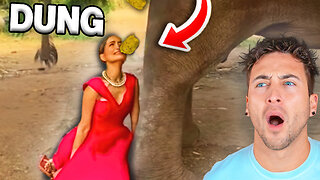Premium Only Content

Plaintiff Claims that "Heart of the Himalayas", is in India, not Pakistan (It's actually in Ne...
Plaintiff Claims that "Heart of the Himalayas", is in India, not Pakistan (It's actually in Nepal).
As you know, the Himalaya Mountains contain most of Earth’s highest peaks. The name is said to come from the Sanskrit Himālaya, meaning “abode of the snow.” This mighty range, up to 200 miles wide, runs for about 1,500 miles from Nanga Parbat in Pakistan to Namcha Barwa in Tibet, also looming over Pakistan, China, Nepal, India, and Bhutan along the way. That would put the heart of the Himalayas somewhere in Nepal.
Or would it?
Mountain ranges don’t actually have hearts, because they are not animals. No, they are made of rocks and dirt. Also a lot of frozen...
As you know, the Himalaya Mountains contain most of Earth’s highest peaks. The name is said to come from the Sanskrit Himālaya, meaning “abode of the snow.” This mighty range, up to 200 miles wide, runs for about 1,500 miles from Nanga Parbat in Pakistan to Namcha Barwa in Tibet, also looming over Pakistan, China, Nepal, India, and Bhutan along the way. That would put the heart of the Himalayas somewhere in Nepal.
Or would it?
Mountain ranges don’t actually have hearts, because they are not animals. No, they are made of rocks and dirt. Also a lot of frozen poop, it turns out, but even around Mount Everest any given volume of mountain will consist almost entirely of rocks and dirt. Like, at least 85 percent of it. The point is, they do not have hearts.
Of course, the word “heart” can also be used in a geographical or metaphorical sense to mean the central or innermost part of something. A mountain range could have a “heart” in that sense, but how would you find it? As you may have noticed, mountain ranges tend to be irregularly shaped, so it’d be hard to find an exact center. Different people would reach different results. There’d be even less agreement over finding the metaphorical “heart” of a terrain feature. Is the “heart” of the Rockies in Colorado, or is it further to the northwest where the middle of the range would be on a map? If it’s in Colorado, is it in Denver, which has most of the people in the region and (arguably) a sports team called the “Rockies,” but isn’t actually “in” the mountains at all? Or is it three hours to the southwest in the town of Salida? That’s where Salida thinks it is. Who’s right?
Nobody. But also, nobody’s wrong, because this is a made-up thing with no objective definition. We could certainly argue about it, but no reasonable person would, for example, file a lawsuit over it.
But of course somebody has. On October 10, Stefany Mogollon sued Costco in the Southern District of New York, alleging that Costco’s “Ground Himalayan Pink Salt” product is deceptively labeled. “Himalayan salt” is apparently a thing now, for reasons I don’t claim to understand. (I did recently and coincidentally discover that Costco’s “Himalayan Salt” kettle chips are the best potato chips yet developed by the human race, though I neither know nor care whether this has anything to do with the salt itself.) Is “Himalayan salt” a real thing? Yes, depending on what you mean by that.
Salt can be found all over the planet, and I just learned the most significant source of it is in Canada, namely the Sifto Salt Mine, which is one-third of a mile under Lake Huron and produces over 7 million frigging tons of rock salt every goddamn year. But what about the Himalayas? Again, yes, depending on what you mean by that.
This term seems most often applied to salt from Pakistan’s (appropriately named) Salt Range. (The Khewra Salt Mine there is the world’s second largest.) This salt has certain trace elements that can give it a pink or reddish color, but it’s otherwise just salt. Ooh, but is it from the Himalayas? Well, arguably, no. The Salt Range is about 200 miles southwest of Nanga Parbat, which, if you were paying attention above, you know is arguably the northwest end of the Himalayas. The Salt Range consists of low mountains or high hills, so that might count, but there seems to be some more flattish space between these and the main range, so … no? But they are a raised area in the western Himalayan region, and now that I zoom in more, the flat area doesn’t look too flat, and it’s all connected underneath anyway, so … yes? Let’s move on from this question, though, because it isn’t at the heart of this lawsuit. Possibly because they realized it would be stupid to quibble about where exactly the Himalayas start and end, and because no reasonable consumer would...
-
 4:40:43
4:40:43
Drew Hernandez
21 hours agoCANDACE OWENS ASSASSINATION PLOT?
25.5K7 -
 1:05:15
1:05:15
Inverted World Live
7 hours agoOne Big Happy Thanksgiving | Ep. 147
72.3K5 -
 2:44:12
2:44:12
TimcastIRL
6 hours agoCandace Owens OFF AIR, Warns France Trying To KILL HER, Says Feds CONFIRM RECEIPT | Timcast IRL
205K154 -
 5:55:35
5:55:35
SpartakusLIVE
6 hours ago#1 King of Content ARRIVES, The Masses UNDULATE with EXCITEMENT
39.3K4 -
 15:51
15:51
Upper Echelon Gamers
7 hours ago $4.45 earned"INFLUENCERS" - House of LIES
16.6K3 -
 1:29:23
1:29:23
Glenn Greenwald
9 hours agoMarco Rubio, Europe Thwart Ukraine Peace Deal; NSA Illegally Leaks Steve Witkoff's Diplomatic Calls; Bari Weiss's Comically Out of Touch Plan for CBS | SYSTEM UPDATE #550
149K90 -
 51:15
51:15
State of the Second Podcast
10 hours agoCan You Trust Paid Gun Reviews? (ft. Tactical Advisor)
31.2K4 -
 8:56
8:56
MetatronGaming
8 hours agoSuper Nintendo NA vs PAL
36.7K9 -
 20:02
20:02
Scammer Payback
10 hours agoHijacking a Scammer Group's Live Video Calls
16.1K4 -
 3:18:30
3:18:30
Nikko Ortiz
8 hours agoArc Raiders 1st Gameplay... | Rumble LIVE
43.2K2